I’ll get to the headline in a minute, but in describing today, a day that resembled yesterday in the exploration of Ethiopia’s Christian past, I’ll share some other observations about what’s happening here.
This morning, I had a campfire breakfast. It wasn’t planned, but the power went out (a problem throughout Africa), dampening my intention of getting up early and sending my blog. When I got to breakfast, I found oatmeal (cooked over sterno), and coffee and hot water for tea, cooked over a fire in the back yard here (the monkeys the owners insist on feeding were nowhere to be found). It was obvious to me that this was not the first time the outage had happened.
My guide had suggested a church that was about 40 kilometers away by road, and 15 if you go on paths over the mountain. It was his choice, and a substitute for what was on my agenda. As usual, it was a good choice, but on the way:
The road was being paved by Chinese (Railway company #3, or something 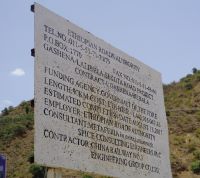 like that)—100 kilometers for around $10 million, which is not a bad deal, I think. I don’t know how the highway will accommodate the goats, cows (plows), people walking with water jugs, etc.
like that)—100 kilometers for around $10 million, which is not a bad deal, I think. I don’t know how the highway will accommodate the goats, cows (plows), people walking with water jugs, etc.
In one of the smaller towns (with circular thatched roofed homes being replaced by corrugated metal roofs and solid walls), there was a USAID food distribution center, passing out food to ease the burden the serious drought is causing 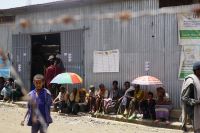 here. The center was mobbed, and while there was some rain a week or so ago that greened up everything, the coming monsoons can make a life or death difference in this country.
here. The center was mobbed, and while there was some rain a week or so ago that greened up everything, the coming monsoons can make a life or death difference in this country.
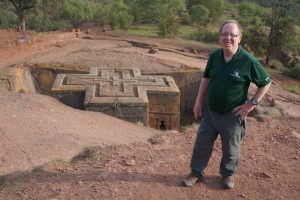
Two of the major churches in Lalibela are being or were being reconstructed by the US embassy. I was glad to see my tax money being spent to fortify enduring cultural monuments.
At the end of our ride was a slightly earlier architectural style church that bridged the gap from where I’ll be tomorrow (another flight; roads are questionable. Addis Ababa is 400 or so miles from here, and it’s a two day journey) to the churches at Lalibela; the older style alternated wood and stone, and looked to me for all 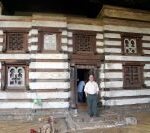 the world like something constructed using Lincoln logs. My guide said the church was probably the palace of a king (the Ethiopians trace the civilization back to 700 B.C., but the modern state dates from the 16thcentury) initially, but it became and still is a church, complete with mummies from long ago who had come as pilgrims and asked to be buried at the church. The only new item was a wall that helps secure the cave site and protect the treasures in it.
the world like something constructed using Lincoln logs. My guide said the church was probably the palace of a king (the Ethiopians trace the civilization back to 700 B.C., but the modern state dates from the 16thcentury) initially, but it became and still is a church, complete with mummies from long ago who had come as pilgrims and asked to be buried at the church. The only new item was a wall that helps secure the cave site and protect the treasures in it.
When we returned to Lalibela, we went to the “heavenly Jerusalem” that King Lalibela constructed, apparently before the “new Jerusalem” I saw yesterday. Lalibela spent 12 years in Jerusalem, and was so fascinated with it (and so stuck on his belief in his divine right to rule) that he recreated the holy city so his subjects would not have to make the long pilgrimage to the holy land.
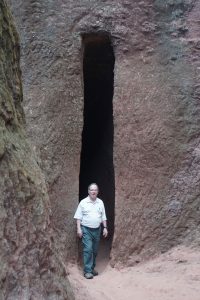
These four churches are carved in much softer rock, and have suffered more damage than the new Jerusalem group. On one, the roof has totally collapsed; one of the lessons for future churches here was that the designers had to account for drainage. And what nature weakened through erosion and time (didn’t the artisans think 600 years ahead?), the Italian occupation hastened with a misguided effort to paint one building a different color, using nails to attach plaster to paint over. When the Italians were defeated and left, the government took out the nails—hence lots of holes creating a weakened structure. For me, probably the most interesting church there was built within a cave, but used the top of the cave as the roof, excavated the sides, and rests on the bottom, so it’s not free standing, not completely carved, and unique, at least here. The churches overall have many similar features, especially the detail work on the windows and some of the interior designs. It’s impressive how much has survived, despite time and temptation; apparently the first church I saw was decorated with jewels at one time. No 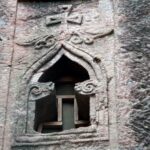 more. Hence, the 1985 security wall that is jarring, almost as much as the UNESCO pillars and roofs that are an attempt to shield the churches from the ravages of time.
more. Hence, the 1985 security wall that is jarring, almost as much as the UNESCO pillars and roofs that are an attempt to shield the churches from the ravages of time.
My favorite church was probably St. George, the last one Lalibela built, built in basalt which is hard and doesn’t need the protective and distracting roof. Shaped like a cross, it is 3 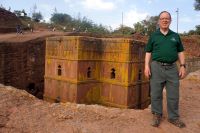 stories high, and reflects the experience curve traveled from the early ones I saw today. If you go to Facebook, I’ll try to post some pictures of it.
stories high, and reflects the experience curve traveled from the early ones I saw today. If you go to Facebook, I’ll try to post some pictures of it.
My favorite experience? After crossing the river Jordan (Lalibela spent 12 years in Jerusalem, remember) and entering the heavenly complex, you enter a chamber known as the “manger,” and from it, there’s a tunnel (no lights allowed) that runs 80 meters to one of the churches. It’s known as “hell,” and by taking that route, I went through hell today.